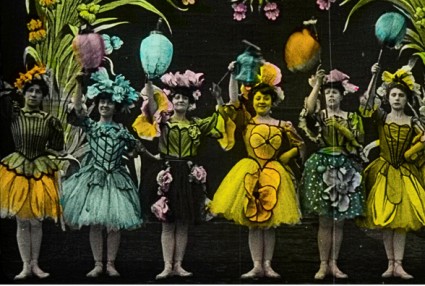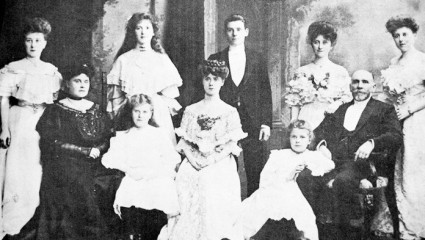Les Fleurs Animées (Pathé, France 1906), from the Corrick Collection in the National Film and Sound Archive of Australia
For the past few years those attending the Pordenone silent film festival have been treated to examples from an extraordinary collection of early films held by the National Film and Sound Archive of Australia. The films are those collected (and in some cases made) by the Corrick Family Entertainers, or The Marvellous Corricks, a performing troupe comprising Albert and Sarah Corrick and their eight children which toured Australia, New Zealand and South-East Asia between 1901 and 1914 and which included film in its act.
The Corricks’ show combined song, comedy, dance, lantern slides, poetry readings and film. Some 135 films survive, chiefly titles the family purchased from France, England, the USA and Italy, plus films that they shot themselves, which includes travel footage, a chase comedy (The Bashful Mr Brown) and film of them on tour. The films they purchased are superb in quality, combining fiction and non-fiction, several films with beautiful colouring (around a quarter of the collection is stencil coloured and another quarter tinted and toned). The Corricks clearly had a fine eye for a good film, favouring particular companies (notably Pathé, Charles Urban Trading Company and Edison). Many of the films are unique to the Corrick collection, and include some real cinematic treasures.
The Corricks c.1898: (Front row) Sarah, Ethel, Alice, Elsie, Albert. (Back row) Amy, Ruby, Leonard (the family’s cinematograph expert), Jessie, Gertrude, from the National Film and Sound Archive
As Leslie Anne Lewis writes in her excellent essay ‘The Corrick Collection: A Case Study in Asia-Pacific Itinerant Film Exhibition (1901-1914)’, Albert and Sarah Corrick planned for a musical family, and trained their children in singing, dancing, bell-ringing and playing a wide variety of musical instruments, among them piano, organ, flute, piccolo, cello, violin, saxophone, mandolin and cornet, with the children often proficient in a number of these. They played in concert halls, town halls and the like, stressing the family-friendly wholesome ness of their show, touring all of the Australian territories up to 1907 before going on an international tour. It was during this tour that they picked up many films, though a projector had been part of their act from the beginning. The family’s cinematograph expert was Leonard Corrick, and his film shows were often billed separately as ‘Leonard’s Beautiful Pictures’. Many people in Australia and South-East Asia saw their first films, and their first views of a world outside their home town, from a Corrick family show. It is evidence of how important variety shows were to early film, how film was integrated within such entertainments to be a part of song, dance and showmanship, and how eventually film outstripped itinerant shows such as those of the Corricks and became the show in itself.
The films began the tortuous process of joining the NFSA collection and gradually being properly preserved in 1968, with the definitive work really only being undertaken recently (see Leslie Anne Lewis’ essay for details). Basic information on all of the films can be found on the NFSA catalogue, with much greater details available for those titles shown at Pordenone by browsing the catalogues of past festivals or using the Pordenone festival’s database (which does not include 2010 screenings as yet). For your convenience (because that is the Bioscope’s mission), here is a list of titles that have been identified and screened so far:
- “AND A LITTLE CHILD SHALL LEAD THEM” (d. D.W. Griffith p.c. Biograph, USA 1909)
- THE ARRESTED TRICAR (GB? c.1905)
- AU JARDIN ZOOLOGIQUE DE PARIS (p.c. Pathé, France 1905)
- A BABY’S SHOE (d. Charles J. Brabin p.c. Edison, USA 1912)
- BABYLAS VIENT D’HÉRITER D’UNE PANTHÈRE (d. Alfred Machin p.c. Pathé, France 1911)
- BAIN DE BÉBÉ (p.c. Pathé, France 1904)
- BASHFUL MR. BROWN (p.c. Corrick, Australia 1907)
- LA BELLE AU BOIS DORMANT (d. Lucien Nonguet, Ferdinand Zecca p.c. Pathé, France 1902)
- BETTINA’S SUBSTITUTE; OR, THERE’S NO FOOL LIKE AN OLD FOOL (d. Albert W. Hale p.c. Vitagraph, USA 1912)
- BICYCLETTE PRÉSENTÉE EN LIBERTÉ (p.c.. Pathé, France 1906)
- A CANADIAN WINTER CARNIVAL (p.c. Edison, USA 1909)
- LE CHAPEAU (p.c. Pathé, France 1906)
- CHASSE AU PAPILLON (p.c. Pathé, France 1906)
- CHASSE AU SANGLIER (p.c. Pathé, France 1904)
- COIFFES ET COIFFURES (d. Gaston Velle p.c. Pathé, France 1905)
- COME CRETINETTI PAGA DI DEBITI (d. André Deed p.c. Itala, Italy 1909)
- COMEDY CARTOONS (d. Walter R. Booth p.c. Urban, GB 1907)
- [CORONATION OF KING EDWARD VII AND QUEEN ALEXANDRA] (GB 1902)
- CRETINETTI LOTTATORE (p.c. Itala, Italy 1909)
- [THE DAY-POSTLE MATCH AT BOULDER RACECOURSE, WESTERN AUSTRALIA] (p.c. Corrick, Australia 1907)
- LES DÉBUTS D’UN CHAUFFEUR (d. Georges Hatot p.c. Pathé, France 1906)
- DEUX BRAVES COEURS (p.c. Pathé, France 1909)
- LE DINER AU 9 (p.c. Pathé, France 1909)
- DON QUICHOTTE (d. Lucien Nonguet, Ferdinand Zecca p.c. Pathé, France 1904)
- DOWN ON THE FARM (p.c. Edison, USA 1905)
- DU CAIRE AUX PYRAMIDES (p.c. Pathé, France 1905)
- FANTASIAS ARABES (p.c. Pathé, France 1902)
- FIRE! (d. James Williamson p.c. Williamson, GB 1901)
- LES FLEURS ANIMÉES (d. Gaston Velle p.c. Pathé, France 1906)
- FUNERAL PROCESSION OF NEW ZEALAND PREMIER R.J. SEDDON (New Zealand 1906)
- LES GRANDES EAUX DE VERSAILLES (p.c. Pathé, France 1904)
- GUILLAUME TELL (d. Lucien Nonguet p.c. Pathé, France 1903)
- THE HAND OF THE ARTIST (d. Walter R. Booth p.c. Paul, GB 1906)
- HER FIRST CAKE (d. James Williamson p.c. Williamson, GB 1906)
- HISTOIRE D’UN PANTALON (p.c. Pathé, France 1906)
- HOW JONES LOST HIS ROLL (d. Edwin S. Porter p.c. Edison, USA 1905)
- AN INDIAN’S GRATITUDE (p.c. Pathé, USA 1911)
- LES INVISIBLES (d. Gaston Velle p.c. Pathé, France 1906)
- J’AI PERDU MON LORGNON (d. Charles Lucien Lépine p.c. Pathé, France 1906)
- [KING EDWARD VII AND QUEEN ALEXANDRA LEAVE A UNIVERSITY GRADUATION CEREMONY] (GB c.1907)
- LIFE OF A COWBOY (d. Edwin S. Porter p.c. Edison, USA 1906)
- LIVING LONDON (p.c. Urban, GB 1904) [note: now identified as THE STREET OF LONDON p.c. Urban, GB 1906)
- THE LOST CHILD (d. Wallace McCuthcheon p.c. Edison, USA 1904)
- THE MAGICAL PRESS (d. Walter R. Booth p.c. Urban, GB 1907)
- MARIE-ANTOINETTE (p.c. Pathé, France 1903)
- LA MÉTALLURGIE AU CREUSOT (p.c. Pathé, France 1905)
- THE MINER’S DAUGHTER (d. James Williamson p.c. Williamson, GB 1907)
- MIRACLE DE NOËL (p.c. Pathé, France 1905)
- MONSIEUR QUI A MANGÉ DU TAUREAU (p.c. Gaumont, France 1907)
- NAVAL ATTACK AT PORTSMOUTH (p.c. Urban, GB 1907)
- NIAGARA IN WINTER 1909 (p.c. Urban, GB 1909)
- PAUVRES VIEUX (Pathé, France 1907)
- LES PETITS PIFFERARI (p.c. Pathé, France 1909)
- LA POUDRE ANTINEURESTHÉNIQUE (p.c. Pathé, France 1909)
- LA POULE AUX OEUFS D’OR (d. Gaston Velle p.c. Pathé, France 1905)
- [PROCESSION OF BOATS ON RIVER, BURMA] (GB c.1905)
- RECEPTION ON, AND INSPECTION OF, H.M.S. “DREADNOUGHT” (p.c. Urban, GB 1907)
- LE REGNE DE LOUIS XIV (d. V. Lorant Heilbronn p.c. Pathé, France 1904)
- LA RUCHE MERVEILLEUSE (p.c. Pathé, France 1909)
- LE SCULPTEUR EXPRESS (p.c. Pathé, France 1907) (p.c. Urban, GB c.1905)
- [THE SHORT-SIGHTED CYCLIST] (p.c. Eclipse, France 1907)
- LE SINGE ADAM II (Pathé, France 1909)
- SPORTS AT SEA ON THE S.S. RUNIC (p.c. Corrick, Australia 1909)
- [STREET SCENES IN PERTH, WESTERN AUSTRALIA] (p.c. Corrick, Australia 1907)
- TOTO EXPLOITE LA CURIOSITÉ (p.c. Pathé, France 1909)
- LE TOUR DU MONDE D’UN POLICIER (d. Charles Lucien Lépine p.c. Pathé, France 1906)
- [TRAVEL SCENES] (p.c. Urban, GB c.1905)
- LA VIE INDIGÈNE AU SOUDAN ÉGYPTIEN (p.c. Pathé, France 1908)
- THE WAIF AND THE STATUE (d. Walter Booth p.c. Urban, GB 1907)
- WHEN THE WIFE’S AWAY (p.c. Paul, GB 1905)
- WHO STOLE JONES’ WOOD? (p.c. Lubin, USA 1909)
- A WINTER STRAW RIDE (d. Wallace McCutcheon, Edwin S. Porter p.c. Edison, USA 1907)
Other films in the collection are still in the process of being identified and preserved – the NFSA catalogue lists these, with such intriguing titles as The Burglar and the Baby, A Canine Arthimetician, Elephants Working in a Burmese Forest, Fée Aux Pigeons, Hallo! Haloo! Grinder, A Japanese Teahouse: Dance of the Geishas, Olympic Games in Athens [1906], and A Trip through Switzerland Engadin Valley.
You can read about the Corrick Collection on the NFSA’s Australian Screen site which includes a number of clips from the films (The Hand of the Artist, La Poule aux Oeufs d’Or and Street Scenes in Perth, Western Australia). There’s another overview on the main NFSA site.
Films from the Corrick Collection are currently featuring in My Bicycle Loves You, a collaboration between the NFSA and physical theatre company Legs on the Wall that combines film footage with live performance to reveal the world of the Corrick Family. It played at the Sydney Festival last week and will be playing at the Perth Festival 22-26 February.


Pingback: Pordenone diary 2011 – day three « The Bioscope
Pingback: Carl corrick | Fairenterprisi